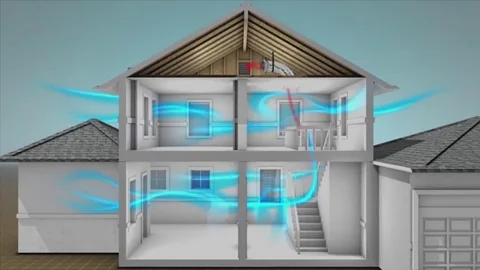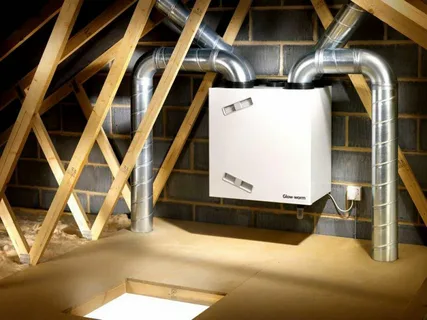In today’s world, where pollution levels are rising and indoor air quality is becoming a growing concern, it is essential to have efficient ventilation systems in place to ensure clean, fresh air indoors. House ventilation systems play a crucial role in maintaining a healthy environment by removing pollutants, odours, and excess moisture from the air. This blog post will explore the importance of ventilation systems, the different types available, and the key features of efficient ventilation for your home or business.
Understanding Ventilation and Its Importance
Ventilation is fundamental to maintaining indoor air quality and is and exchanging stale indoor air with fresh outdoor air. This process is vital for eliminating pollutants that accumulate inside, including carbon dioxide, volatile organic compounds (VOCs), and allergens. These substances can originate from various sources, such as household cleaning agents, building materials, and even human respiration.
In the absence of effective ventilation, these pollutants can reach harmful levels, leading to respiratory problems, allergies, and other health issues. Furthermore, poor ventilation can exacerbate humidity levels, encouraging the growth of mould and mildew, which pose additional health risks and damage building structures. By implementing a robust ventilation strategy, you can safeguard against these hazards, ensuring that indoor spaces remain healthy, comfortable, and conducive to the well-being of occupants.
 The Role of Advanced Ventilation Systems
The Role of Advanced Ventilation Systems
Advanced ventilation systems utilise cutting-edge technologies to enhance the air exchange while significantly reducing energy expenditure. Amongst these, Heat Recovery Ventilation (HRV) and Energy Recovery Ventilation (ERV) stand out for their ability to capture heat from expelled indoor air and transfer it to the incoming fresh air. This innovative approach ensures minimal heat is lost during ventilation, making these systems exceptionally energy-efficient.
Furthermore, they adeptly manage the internal climate by maintaining an optimal balance of temperature and humidity, contributing to a more comfortable and healthier indoor environment. By leveraging such technologies, advanced ventilation systems not only support the well-being of occupants by ensuring a supply of clean, fresh air but also align with sustainable practices by conserving energy.
They are particularly beneficial in regions experiencing extreme temperatures, where maintaining indoor air quality without compromising energy consumption poses a significant challenge. Their implementation can lead to substantial energy savings and contribute to a reduction in the overall carbon footprint of a building, showcasing a seamless blend of comfort, efficiency, and environmental responsibility.
Different Types of Ventilation Systems Explained
Navigating the landscape of ventilation systems reveals many options, each designed to cater to distinct preferences and structural requirements. Mechanical ventilation systems are prominent for their ability to actively circulate air using fans or blowers, which is an ideal choice for environments where natural airflow is insufficient. On the other end of the spectrum, Natural Ventilation harnesses the power of wind and thermal buoyancy to facilitate air movement through openings, windows, or vents, offering an energy-efficient solution by capitalising on the natural environment.
Balanced Ventilation systems strike a harmonious equilibrium, simultaneously supplying fresh air while extracting an equal volume of stale air, ensuring a consistent and comfortable indoor atmosphere. This method effectively mitigates energy loss without compromising air quality. Conversely, Exhaust Ventilation systems focus on removing poor-quality air from specific areas, such as kitchens or bathrooms, through vents or ducts, making them a targeted solution for reducing humidity and odour.
Each system presents unique advantages tailored to diverse architectural designs, occupancy levels, and geographical climates. Selecting the appropriate ventilation method requires thoroughly assessing these variables to achieve an optimal blend of air quality, energy efficiency, and occupant comfort.
Key Features of Efficient House Ventilation
An efficient house ventilation system is characterised by several crucial attributes that contribute to its performance, sustainability, and the overall health of the indoor environment. Foremost among these is its energy efficiency, which signifies the system’s capability to maintain superior air quality with minimal energy consumption. This is particularly important in today’s eco-conscious world, where the emphasis on reducing energy usage is paramount.
Another key feature is the incorporation of heat recovery mechanisms. Such systems adeptly recapture heat from expelled indoor air and utilise it to warm the incoming fresh air, thereby significantly lowering heating demands and costs associated with maintaining a comfortable indoor temperature.
Air filtration also plays a pivotal role, with efficient systems equipped to eliminate pollutants, allergens, and odours, ensuring fresh and healthy air within the premises. This is complemented by effective humidity control, which aids in mitigating moisture levels to deter mould growth and sustain a pleasant indoor atmosphere.
Lastly, the aspect of quiet operation cannot be overstressed. An efficient ventilation system operates unobtrusively, ensuring that it does not disrupt the occupants’ daily activities with excessive noise. Together, these features underscore the essence of efficient house ventilation, focusing on creating an optimal living environment that champions health, comfort, and energy conservation.
Installing a Ventilation System: What You Need to Know
Embarking on installing a ventilation system necessitates a strategic approach underpinned by a comprehensive understanding of several pivotal factors. The architecture and dimensions of the premises play a critical role in influencing the choice and configuration of the system to ensure it effectively circulates air throughout the space.
Furthermore, the occupancy rate, reflecting both the number and activities of the inhabitants, directly impacts the volume of air exchange required to maintain a healthy environment. The characteristics of the local climate, including temperature ranges and humidity levels, also dictate the type of ventilation system that would be most effective, ensuring it can adequately respond to external environmental conditions.
Additionally, aligning the selection with financial considerations and aspirations towards energy efficiency is imperative, balancing upfront costs against long-term savings and environmental benefits. Engaging with a qualified professional can offer invaluable insights, guiding the selection process towards a ventilation solution that harmoniously aligns with specific needs, architectural constraints, and environmental objectives. This tailored approach guarantees the enhancement of indoor air quality and the optimisation of energy consumption, embodying a commitment to sustainability and well-being.
The Health Benefits of Clean, Fresh Air
Breathing clean, fresh air is paramount for our overall health and well-being. Adequate ventilation is crucial in mitigating the risks associated with airborne contaminants, which can lead to a spectrum of respiratory conditions, aggravate allergies, and heighten susceptibility to viral and bacterial infections. The consistent renewal of indoor air through effective ventilation systems ensures the dilution and removal of potentially harmful particles and gases.
This process is instrumental in creating a living or workspace that promotes physical health and enhances cognitive function and productivity. Studies have shown that environments with high-quality air circulation can improve concentration, reduce headaches, and lower the incidence of sickness among occupants. Furthermore, fresh air can elevate mood and energy levels, making indoor spaces more enjoyable and livable. Ensuring our surroundings are infused with clean air is a simple yet powerful way to nurture a healthier, more vibrant lifestyle.
Ventilation Systems and Energy Efficiency: What’s the Connection?
Ventilation systems are pivotal in the symbiotic relationship between indoor air quality and building energy efficiency. The core functionality of these systems, which facilitates the exchange of indoor and outdoor air, can significantly influence a building’s thermal demands. By introducing fresh air and expelling stale air, ventilation helps maintain a comfortable indoor temperature, reducing the reliance on heating and cooling systems. This reduction is instrumental in lowering energy consumption and utility bills.
Integrating advanced technologies like Heat Recovery Ventilation (HRV) and Energy Recovery Ventilation (ERV) exemplifies the innovative strides in this domain. These systems are adept at reclaiming a substantial portion of the heat from the expelled air. Such a process ensures that the energy, which would otherwise be lost, is instead utilised to pre-heat or pre-cool incoming fresh air. This recycling of energy markedly enhances the energy efficiency of buildings, diminishing the environmental footprint and facilitating a sustainable lifestyle.
Moreover, the strategic design of modern ventilation systems allows for meticulous airflow control, ensuring that energy is not wastefully expended on over-ventilation. By optimising the amount of air exchanged based on a building’s occupancy and specific needs, these systems ensure that energy efficiency is maximised without compromising on air quality. This harmonious balance underscores the critical connection between ventilation systems and energy efficiency, heralding a new era of environmentally conscious and economically viable building design.
Maintenance Tips for Your Ventilation System
Maintaining your ventilation system is paramount to ensuring it operates at peak efficiency and continues to provide clean, fresh air to your indoor environment. Here are some essential maintenance practices to adopt: Firstly, ensure that filters are either cleaned or replaced at regular intervals, typically every three to six months, depending on usage and the manufacturer’s recommendations. This is crucial for preventing blockages that impede airflow and degrade air quality. Secondly, inspecting ductwork and vents periodically for any signs of blockage or damage is important. Keeping these components clean enhances the system’s effectiveness and efficiency.
Additionally, reassess and adjust the ventilation settings according to seasonal changes or alterations in occupancy to maintain optimal air quality and energy use. Regular professional inspections and maintenance checks should not be overlooked; they are key to diagnosing and rectifying potential issues before they escalate into costly repairs. By adhering to these maintenance tips, you can ensure your ventilation system remains in top condition, supporting a healthy and energy-efficient indoor atmosphere.
Conclusion
Investing in an efficient ventilation system represents a proactive step towards enhancing the quality of life within indoor spaces. Adopting such technology facilitates the circulation of clean, fresh air and plays a significant role in energy conservation, echoing the modern ethos of sustainability. It’s about creating spaces that feel good to inhabit and demonstrate a commitment to preserving our environment. The journey towards improved air quality and energy efficiency within our homes and businesses is a testament to our collective responsibility towards the planet and our personal health. Engaging with these systems offers a pathway to a more breathable, vibrant, and sustainable world.
FAQs
How do I choose the right house ventilation system for my property?
Selecting the ideal ventilation system involves several factors, including your property’s layout, occupancy, and the specific climatic conditions of your area. A detailed consultation with a ventilation expert is advisable to ensure the system effectively meets your requirements.
How frequently should the filters in my ventilation system be replaced or cleaned?
To maintain the efficiency and air quality of your ventilation system, cleaning or replacing the filters regularly is essential. Typically, this should occur every three to six months, but this can vary based on the system’s usage and the manufacturer’s guidance.
Can an efficient ventilation system contribute to lower energy costs?
Indeed, by optimising the balance between air quality and energy use, efficient ventilation systems can play a pivotal role in reducing the need for additional heating and cooling, potentially lowering energy expenses. Implementing systems equipped with heat recovery technologies can further enhance these savings by reutilising heat from expelled air.
I should be aware of maintenance practices specific to ventilation systems.
Regular maintenance is crucial for the longevity and performance of your ventilation system. This includes routine checks and cleaning of filters, ducts, and vents to prevent obstructions that can affect airflow and quality. Adjusting settings in response to changing occupancy or seasons and scheduling professional inspections are key to ensuring your system functions effectively.
| Other Good Articles to Read |
| Blogs-Nation |
| Blogs-Peoples |
| Bryan Smith Blogs |
| intellect blogs |
| the fault in our blogs |
| blogs eu |
| oz forums |
| recruitment blogs |
| zet blogs |
| id blogs |
| Blog Studio legale |
| blogs map |
| Related Business Listings |
| Contact Directory |
| Local Business Profiles |
